Biology Topic 8- Grey Matter
1/78
Earn XP
Description and Tags
Topic 8 key definitions and functions of the nervous system's structures.
Name | Mastery | Learn | Test | Matching | Spaced |
|---|
No study sessions yet.
79 Terms
neurone/ nerve fibre
a single cell that transmits an impulse

sensory neurone
function: dendrites synapse with receptor cells to conduct an impulse to the CNS
location: dendrites and dendron outside CNS but cell body in the dorsal root ganglia at the entrance to the spinal cord
structure: cell body between axon and dendron above the plane. short axon but long dendron

relay neurone
function: dendrites synapse with sensory neurones, terminal branches synapse with motor neurones
location: whole neurone within the CNS
structure: cell body between axon and dendron

motor neurone
function: dendrites synapse with relay neurones, terminal branches synapse with effector cells
location: cell body within the CNS, axon leaves the CNS
structure: dendrites lead into cell body (no dendron), long axon
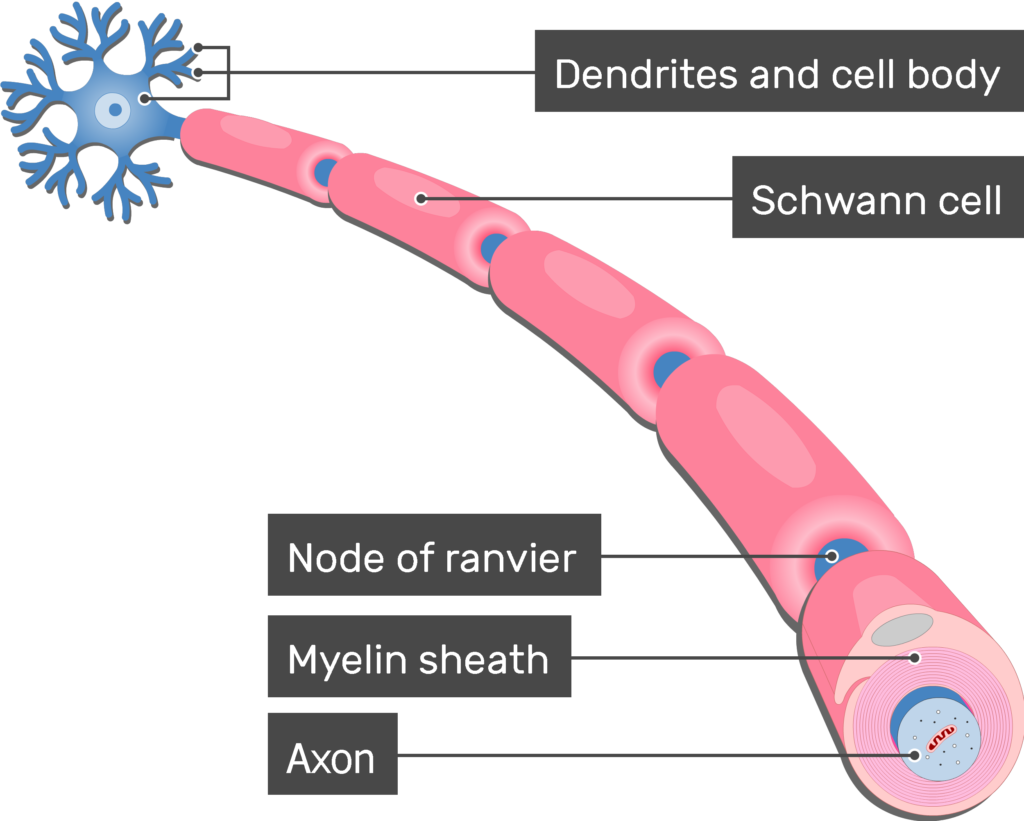
function of myelin sheath and the advantages of it structure
the myelin sheath is formed of Schwann cells, and wraps around the axon to provide protection from damage. it is composed of a predominantly lipid membrane which allows it to act as an electrical insulator preventing depolarisation of the neurone where it is present.
nodes of Ranvier
gaps between cells that provide an area along the axon where depolarisation can occur. transmission is therefore faster as the impulse jumps from node to node (saltatory conduction)
axon
carries impulses away from the cell body
dendron
carries impulses towards the cell body
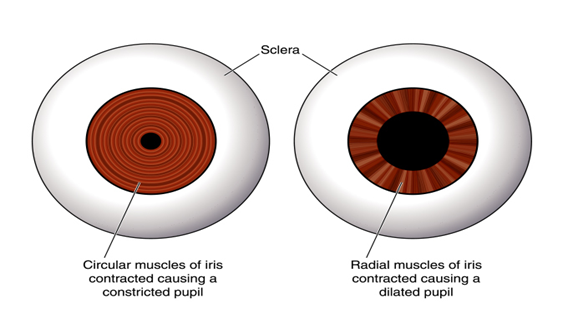
the pupil reflex
the autonomic nervouse system controls the antagonistic pair of muscles in the iris:
to increase the diameter of the pupil (sympathetic nervous system), the radical muscles contract, and the circular muscles relax
to decrease the diameter of the pupil (parasympathetic nervous system), the circular muscles contract, and the radical muscles relax
the resting potential
the potential difference across the cell membrane of a neurone at rest, usually -70mV.
to conduct an impulse the inside of the membrane must initially be more negative on the inside- the membrane must be polarised
depolarisation
the rapid influx of sodium ions into the neurone which cause an increase in the charge inside the cell membrane and the membrane potential to increase- usually +40mV
hyperpolarisation
the drop in membrane potential below the resting potential due to open K+ channel- usually -80mV
threshold potential
the point at which a sufficient amount of sodium ion channels open for the influx of Na+ into the axon is greater than the outflow of K+ ions- usually -55mV
all-or-nothing response
any generator potential that reaches the threshold level will produce an action potential of equal magnitude
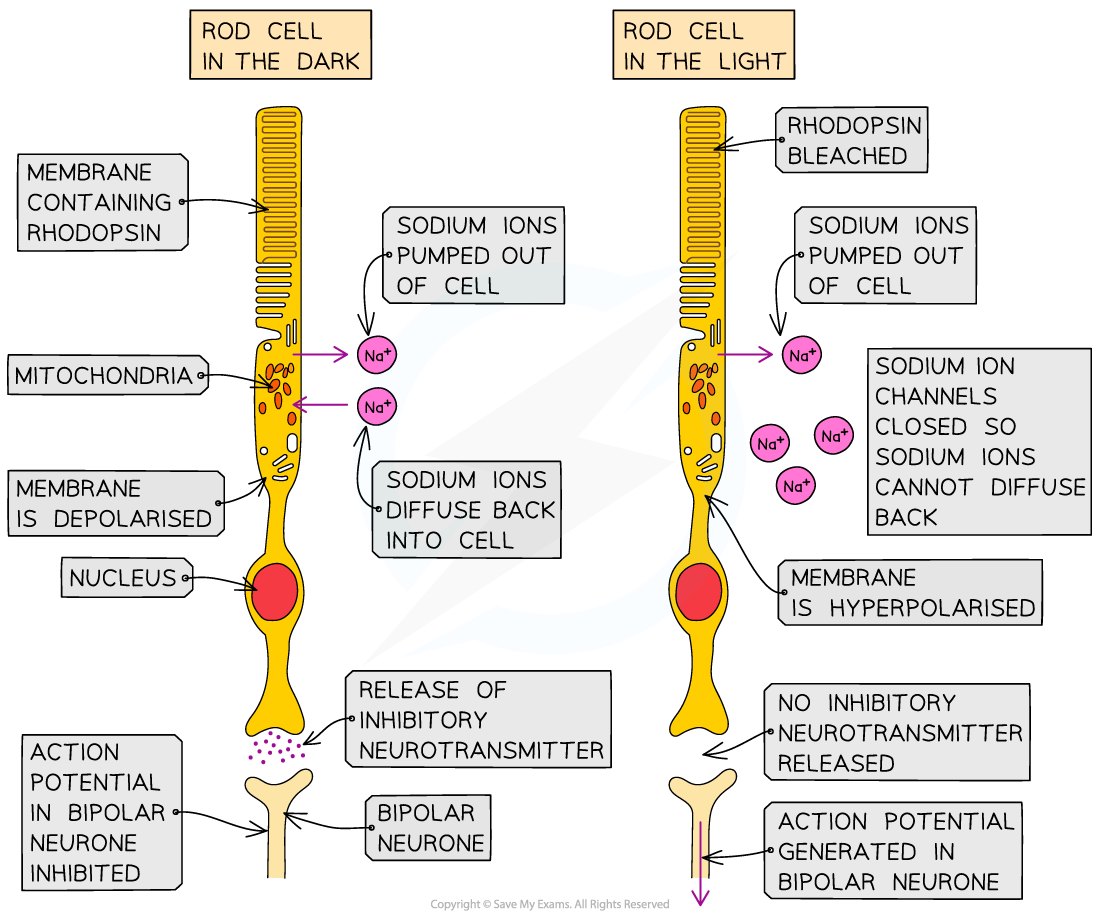
primary photoreceptor: rod cell
provides black and white vision and is specialised to work in dim light. contains rhodopsin
primary photoreceptor: cone cell
colour vision
rhodopsin structure and function
photochemical pigment located in the membranes of vesicles in the outer segment of rod cells. upon absorption of light, it breaks down into retinal and opsin
retinal
non-protein that converts from cis-retinal to trans-retinal
opsin
protein that activates a series of membrane bound reactions ending in the hydrolysis of a cyclic nucleotide to result in the closure of non-specific cation channels in the membrane of the outer segment
glutamate
neurotransmitter that is released from rod cell in the dark and binds to bipolar cell and causes its membrane to becomes hyperpolarised, preventing an action potential
dark adaptation
enables the eye to transition from a high light setting to a low light setting to restore retinal sensitivity. involves the conversion of trans-retinal to cis-retinal to recombine with opsin to form rhodopsin- requires ATP and can take upto 50 minutes
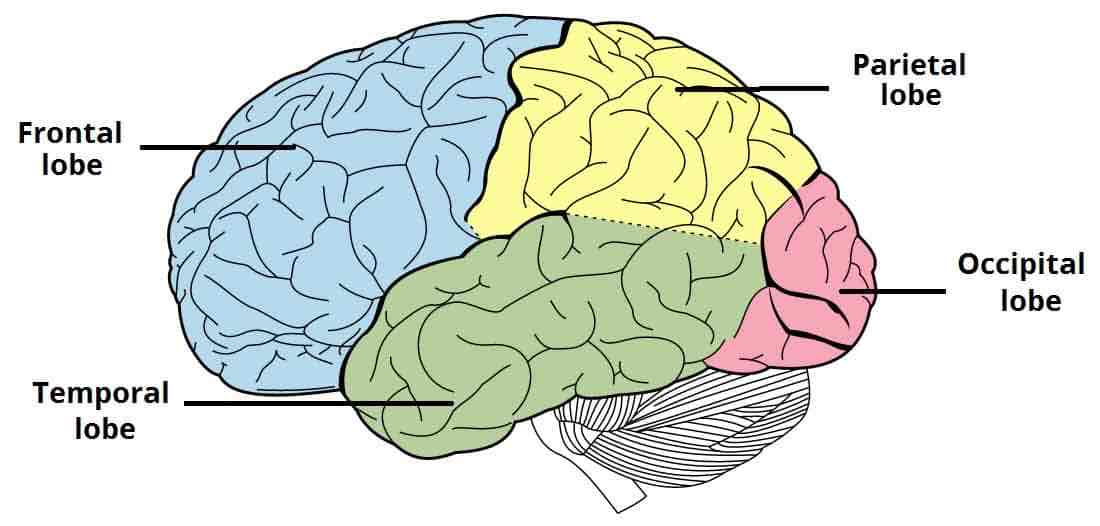
structure of the cortex/ cerebrum
grey matter- highly folded outer layer composed of nerve cell bodies, synapses and dendrites.
white matter- underneath the grey matter, composed of millions of myelinated axons connecting neurones in different areas
the cortex is divided into two cerebral hemispheres
frontal lobe
decision making, reasoning, planning, emotion, forming associations
temporal lobe
process of auditory information, hearing, sound recognition, speech, memory
occipital lobe/ visual cortex
processes information from the eyes: vision; colour; shape; perspective
parietal lobe
orientation, sensation, calculation, recognition, memory
motor cortex
connects to spinal cord, brain stem and muscles via motor neurones. stores informtaion about how to carry out movement
corpus callosum
white matter composed of axons: allows connection between the two hemispheres and the brain structures
medulla oblongata
regulates heart rate (cardiovascular control centre), breathing rate (ventilation centre), and blood pressure
cerebellum
balance: coordinates movement as it is being carried out
hypothalumus
controls thermoregulation (thermoregulatory centre), thirst, hunger, circadian rhythms, and sleep- acts as an endocrine gland and stimulates the pituitary gland
thalamus
routes all incoming sensory information to the correct lobes
basal ganglia
selects and initiates stored programmes for movement
hippocampus
involved in laying down long-term memory
pituitary gland
endocrine gland responsible for secreting hormones hat control growth, blood pressure, energy management, sex organs, thyroid gland, metabolism, pregnancy, childbirth, nursing, water/ salt concentration at the kidneys, temperature, pain relief
midbrain
relays information to the cerebral hemispheres
pons
relays information from the forebrain to the cerebellum and the medulla. involved in sleep, breathing, respiration, swallowing, bladder control, hearing, taste, eye movement, facial expressions and sensations. implicated in sleep paralysis and dreaming.
MRI (magnetic resonance imaging)
combination of a magnetic field and radio waves that cause hydrogen nuclei to change orientation and release energy that is detected and converted into an image.
can be used for identifying soft tissues, tumour location and size, stroke damage, injuries to brain, spinal cord and joints
advantages- does not use X-rays, thin slices of image are created to produce a 3D image, better resolution that CT
disadvantages- loud noise, small imaging space- not good for small children or people with claustrophobia or special needs, cannot be used on people with metal implants.
fMRI (functional magnetic resonance imaging)
areas of high neural activity can be seen as ‘lighting up’ - these areas have a high demand for oxygen and so blood flow to them increases. oxyhameoglobin in the blood does not absord fMRI signals (radio waves) and so the areas with high activity will absorb less radio wave. must comapre with brain activity at rest
able to study the brain in action and determine different areas of the brain associated with human activities
advantages: no X-rays, very high resolution and 4 images produced per second so a process can be followed over a short period of time
disadvantages: expensive, patient must lie completely still, only measures blood flow and not how individual neurones are behaving
CT scans (computerised axial tomography)
narrow beam X-rays are fired at different angles around the patient where the beam is reduced in strength depending on the density of the tissue. X-rays are then detected and slices of tissue are created
used for investigating soft tissues ie. brain, tumour growth
advantages: more resolution than broad beam X-ray, soft tissues can be imaged
disadvantages: X-rays not good for pregnant women, pixture is frozen, looks at structure rather than function, limited resolution so small structures cannot be distinguished
PET scans (positron emission tomography)
radiotracers (isotopes with short half-lives) are incorporated into compounds such as water, glucose, or molecules that bind to receptors. the radiotracers are injected into the patient’s bloodstream. blood flow will increase to areas of activity in the brain due to greater oxygen and glucose demand. the radiotracers moved to these areas wil emitt positrons as they decay, which will collide with electrons in the tissue, producing gamma rays which are then picked up by detectors and converted to a signal, and an image is produced. the brighter the area the more the neural activity.
can be used in the diagnosis and monitoring of heart disease, cancer, and brain disorders
advantages: can follow changes in disease progression or treatment if video images are played in succession
disadvantages: expensive, radioactive tracers mean it can only be carried out once or twice a year, after a scan the patient cannot travel by public transport due to potentially coming into contact with a pregnant person
critical period
period during visual cortex development where exposure to many different visual stimuli is required for full development of neural connections
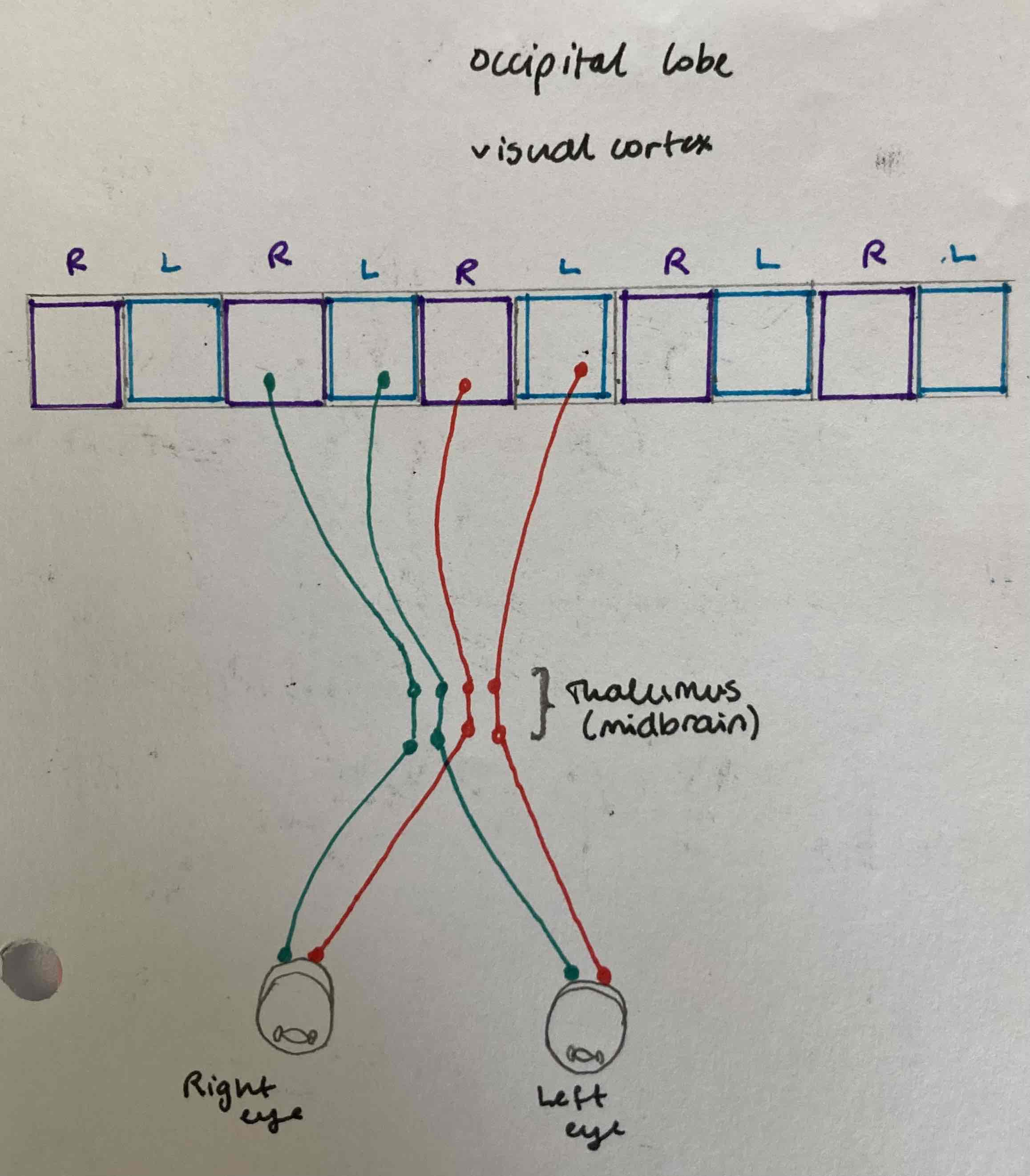
link from retina to the occipital lobe
axons leaving the retina arrive at the thalumus
the axons then leave and each connect up with a specific occular dominance olumn cell in the visual cortex in the occipital lobe
perception
creation of an image, involving knowledge and experience to interpret sensory information from the retina- has to be learnt (not innate)

examples of depth perception studies
cross cultural studies (carpented world hypothesis), crawling babies (visual cliff experiment)
Hubel and Weisel experiment
newborn kittens and monkeys exposed to monocular deprivation for different lengths of time during their critical period. when exposed to light, the column cells in the visual cortex corresponding with the light deprived eye did not respond.
habituation and its importance
the effect seen when animals gradually stop responding to a stimulus after repeated exposure
allows animals to ignore and prevent wasting energy on unimportant stimuli to concentrate on more threatening or rewarding stimuli
morality
concepts concerned with the code of behaviour considered right or acceptable for the norm of a particular society
ethics
concepts concerned with what is right and what is wrong regardless of moral concerns
absolutism
the view that something should not be done for any reason
relativism
view that there may be circumstances where something is justified normally when the benefits of a research outweighs the harm to the animals
arguments for animal research
benefits of the research may outweigh the harm to the animals
invertebrates have less complex/no nervouse systems so will feel less/no pain
many mammals have the same organs performing the same functions
non-animal methods do not provide enough information
all research involving animals is approved by the home office and inspectors check animal welfare
regulation is underpinned by the three R’s
arguments against animal research
use of any animal is wrong or unethical
vertebrates have complex nervous systems- can feel pain
animals cannot give consent- they have rights
animal coukd die or be permenantly affected
significant species differences mean that it is not possible to extrapolate data for human accurately
alternatives such as tissue culture can be used
some research could be viewed and not essential
phototropism
plants can detect the quantity, direction, wavelength, and duration of light
detected by photoreceptors
plant cues
heliotropism- directional movement of the sun
hydrotropism- water
chemitropism- chemicals
geotropism- gravity
thermotrapism- temperature
thigmotropism- sense of touch
electrotropism- electric current
aerotropism- oxygen concentration
hygrotropism- humidity
what happen when a plant is exposed to red light
Pr absorbs the red lightand converts to Pfr
Pfr accumulation initiates developmental processes in long day plants
what happen when a plant is exposed to far-red light
Pfr absorbs light and converts back to Pr
can also occur during the night
what determines flowering
ratio of Pr to Pfr- indicates to the plant the photoperiod and night
long day plants
only flower when period of uninterrupted darkness is less than 12 hours- Pfr stimulates flowering
short day plants
only flower when period of uninterrupted darkness is more than 12 hours- Pfr inhibits flowering
greening
once the shoot has broken the surface of the soil phytochromes promote primary leaf development unrolling and production of photosynthetic pigments , inhibition of cell elongation in the internodes
activation of Pfr
activated phytochrome interacts with other proteins to initiate a signal transduction pathways. signal proteins are or navigate transcription factors to bring about transcription of light-regulated genes
plant hormone (auxin)
IAA (indoleacetic acid)
candidate gene
gene that causes a disease
DNA sequencing- analysis of DNA to find candidate genes
any mutations that are specifically different to the population
DNA of affected people is compared to that of unaffected people
SNP- single nucleotide polymorphism
variation when one nuleotide is substituted and must occur in at least 1% of the population as a particular SNP could predispose people to disease
use of a candidate gene
The whole population, or affected individuals in the population, can be screened for mutations in the gene
drug target
A specific molecule (a protein) that a drug interacts with to bring about an effect
pharmacogenics
prescribing drugs based on a person’s genome
ethical dilemmas of genetic testing and personalised medicine
discrimination of people with genes for diseases in insurance
decision making on who should have the tests
records and access to data
maintaining confidentiality
availability privately for people who can pay
treatments will be expensive at first
who is eligible
antibiotic resistance in genetic modification
gene could be transferred to pathogen bacteria
risks of animal modification
risk of protein made by GMO being a health hazard
virus as vectors
people chosing wether to eat GMO food
risks of plant modification
transfer of gene to non target species by cross pollination, allowing other species to outcompete eg creation of superweed- can ensure outcrosses are infertile or develop technology to prevent pollen from containing the DNA
use of herbicides or pesticides can act as a selection pressure to weeds which may become resistant
crop ownership- some farmers can afford the technology but some cant
nature and nurture in the critical period
nature- volumn cells present at birth
nurture- development during critical period results in less overlap between territories of different axons
neural plasticity
the changes occurring in our network of network of neurones by modification of synapses that underpin learning and memory
critical window
synapses made, maintained, and pruned for correct development of visual cortex so the neurones can respond to information from the retina
cross cultural studies
carpented worth hypothesis and depth clues and linear perspective
crawling babies
visual cliff experiment